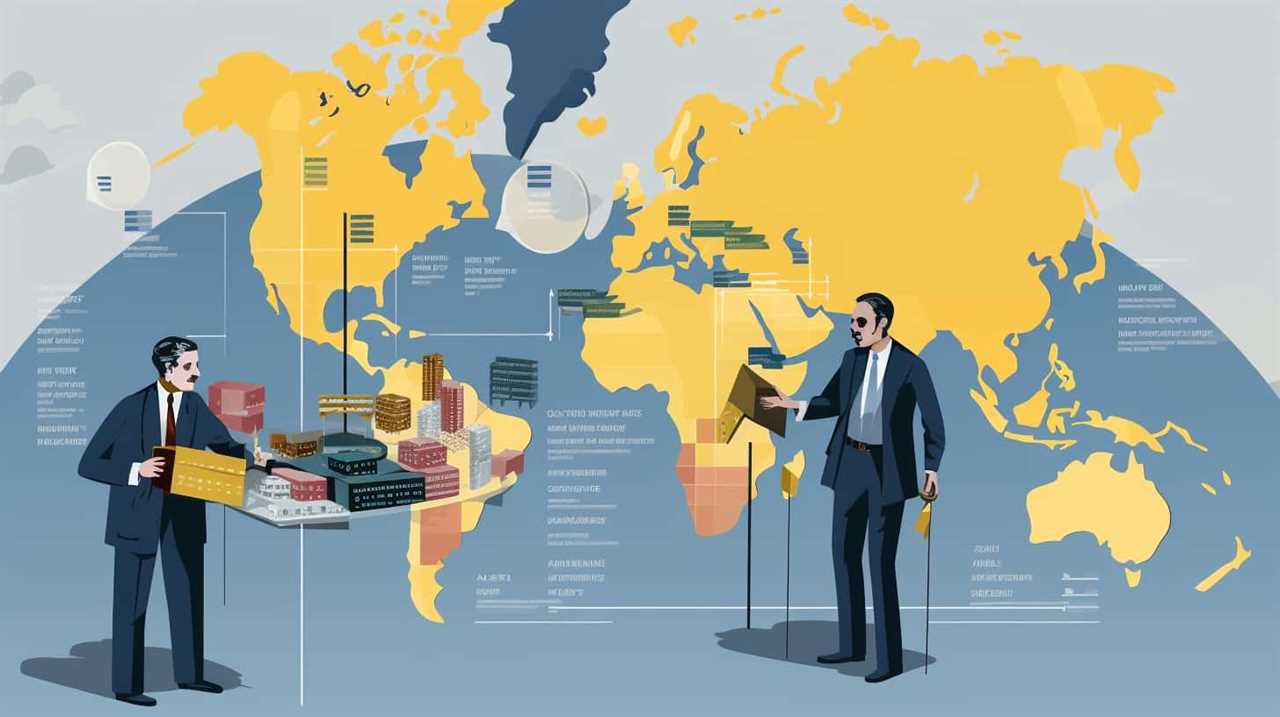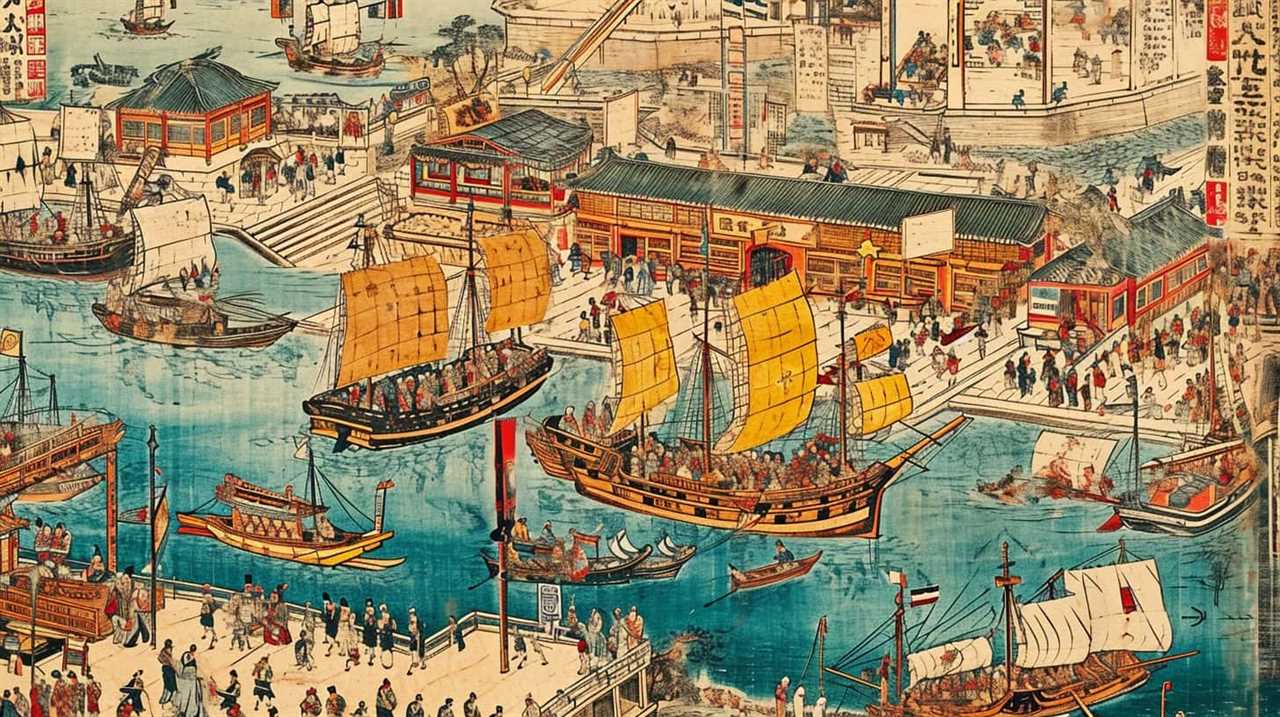Are you prepared to uncover the groundbreaking principle that transformed worldwide commerce? Be prepared to be astonished by Ricardo’s Theory of Comparative Advantage!
This groundbreaking theory, developed by the brilliant economist David Ricardo, unlocked the secret to maximizing innovation and efficiency in international commerce. By understanding and harnessing our unique strengths, we can unleash a wave of innovation that propels us to new heights of economic success.
But what exactly is this principle? How does it work? And why is it so crucial in today’s ever-evolving world? Join us as we delve into the depths of Ricardo’s Comparative Advantage Principle and unlock the key to unleashing our true potential in the realm of global trade.
Key Takeaways
- Comparative advantage is a principle in international trade theory introduced by economist David Ricardo in the early 19th century.
- It states that one country can produce a good or service at a lower opportunity cost than another country.
- Comparative advantage allows for mutually beneficial trade between countries and leads to increased efficiency and productivity through specialization.
- It fosters innovation, drives sustainable economic development, expands consumer choices, and provides insights into the potential gains from trade.
Definition of Comparative Advantage
We, as economists, understand comparative advantage as the concept that one country can produce a good or service at a lower opportunity cost than another country, allowing for mutually beneficial trade. Comparative advantage is a fundamental principle in international trade theory, first introduced by economist David Ricardo in the early 19th century. It’s based on the idea that even if one country is more efficient in producing all goods compared to another country, there are still gains from trade if each country specializes in producing the goods in which it has a comparative advantage.

To fully grasp the concept of comparative advantage, it’s essential to understand the notion of opportunity cost. Opportunity cost refers to the value of the next best alternative that’s forgone when making a choice. In the context of comparative advantage, it means that a country must give up producing one good or service to produce another. The country with a lower opportunity cost of producing a particular good has a comparative advantage in that good.
By specializing in the production of goods or services in which they’ve a comparative advantage, countries can achieve higher levels of efficiency and productivity. This specialization allows countries to allocate their resources effectively, leading to increased output and economic growth. Furthermore, through trade, countries can access goods and services that they can’t produce efficiently themselves, leading to an expansion of consumer choices and overall welfare.
Understanding the concept of comparative advantage is crucial for policymakers and businesses in today’s globalized and interconnected world. It provides insights into the potential gains from trade and the importance of specialization in a competitive market. By embracing the principles of comparative advantage, economies can foster innovation, expand their markets, and drive sustainable economic development.
Ricardo’s Contribution to Classical Economics
Ricardo’s contribution to classical economics is significant and continues to shape modern economic thought. His theories, such as the theory of comparative advantage, revolutionized the understanding of international trade and specialization.

Ricardo’s work laid the foundation for the concept that nations should focus on producing goods and services in which they have a comparative advantage. This concept leads to increased efficiency and overall economic growth.
Ricardo’s Economic Theories
One of the key contributions to classical economics was made by David Ricardo. Ricardo’s economic theories have had a significant impact on the field and continue to influence modern economics.
One of his notable concepts is the definition of absolute advantage, which refers to a country’s ability to produce a good or service more efficiently than another country. Ricardo argued that even if one country has an absolute advantage in the production of all goods, both countries can still benefit from trade based on their opportunity costs.
Opportunity cost is the value of the best alternative forgone when making a choice. This concept highlights the importance of trade and specialization, as countries can focus on producing goods in which they’ve a comparative advantage. This leads to increased efficiency and overall economic growth.

Ricardo’s economic theories have paved the way for modern trade theory and continue to shape our understanding of international economics.
Moving forward, let’s explore the impact of Ricardo’s economic theories on modern economics.
Impact on Modern Economics
Moving forward, let’s delve into how Ricardo’s economic theories have shaped modern economics and their contributions to classical economics.
Ricardo’s comparative advantage principle has had a significant impact on international trade and played a crucial role in globalization. By emphasizing specialization and trade between nations based on their relative efficiencies, Ricardo’s theories have provided the foundation for understanding the benefits of free trade and the gains from international exchange.

His insights have shaped the way economists analyze the patterns and determinants of trade, leading to the development of theories such as the Heckscher-Ohlin model and the New Trade Theory.
Furthermore, Ricardo’s ideas have influenced policies promoting liberalization and integration of economies, fostering global economic cooperation and enhancing overall welfare.
In a world increasingly interconnected through trade and globalization, Ricardo’s contributions remain highly relevant and continue to shape modern economic thinking.
Key Assumptions of Comparative Advantage Theory
In our discussion of the key assumptions of comparative advantage theory, we’ll explore the fundamental principles that underlie this economic concept. These assumptions have a significant impact on economics and shape the way we understand international trade.

The first assumption is that there are only two countries and two goods involved in trade. This simplification allows economists to analyze the concept more easily and draw clear conclusions. However, in reality, there are usually more countries and a wider range of goods being traded.
The second assumption is that resources are perfectly mobile within countries but immobile between countries. This means that labor and capital can move freely within a country to produce different goods, but can’t move across borders. This assumption helps to explain why countries specialize in producing certain goods, as they can allocate their resources more efficiently.
The third assumption is that there are constant returns to scale. This means that the production of goods can be increased proportionally when more resources are used. This assumption enables economists to understand how countries can benefit from trade even if one country is more efficient in producing all goods.
Explanation of Absolute Advantage
When discussing the explanation of absolute advantage, it’s important to understand its definition and the benefits it brings.

Absolute advantage refers to a situation where one country can produce a good or service more efficiently than another country. This allows the country with absolute advantage to produce more output using the same amount of resources.
The benefits of absolute advantage include increased productivity, specialization, and higher economic output.
Absolute Advantage Definition
To understand the concept of absolute advantage, we must first define it as the ability of one country or individual to produce a good or service with fewer resources than another country or individual.
Absolute advantage is different from comparative advantage, which focuses on the opportunity cost of producing one good or service over another.

Absolute advantage looks at the overall efficiency of production, regardless of opportunity cost. It’s a measure of productivity and efficiency in terms of resource usage.
For example, if one country can produce 100 units of a good with the same amount of resources that another country can produce only 50 units, the first country has an absolute advantage in the production of that good.
Understanding absolute advantage is essential in determining trade patterns and maximizing efficiency in global markets.
Benefits of Absolute Advantage
We greatly benefit from absolute advantage as it allows us to produce goods or services with fewer resources than others. This understanding of absolute advantage opens up opportunities for innovation and growth.

By being able to produce more efficiently, we can allocate our resources towards other areas of production, research, or development. This leads to increased productivity and competitiveness in the market.
Additionally, absolute advantage enables us to specialize in the production of goods or services that we excel at, while relying on others for those that they have an absolute advantage in. This promotes trade and cooperation among nations, fostering economic interdependence and mutual benefit.
Understanding Opportunity Cost in Trade
Often, as traders, we must carefully consider the opportunity cost of our decisions in order to maximize our comparative advantage and achieve the most efficient outcomes in trade. Opportunity cost analysis involves evaluating the trade-offs involved in international trade. By understanding the concept of opportunity cost, we can make informed decisions that lead to better outcomes.
Opportunity cost is the value of the next best alternative that is forgone when making a decision. In the context of trade, it refers to the potential benefits that could have been gained from engaging in an alternative trade activity. By comparing the benefits and costs of different options, we can determine the most advantageous course of action.

To illustrate this concept, let’s consider the following table:
| Option A | Option B | Option C | |
|---|---|---|---|
| Benefit | $500 | $600 | $700 |
| Cost | $400 | $450 | $600 |
In this scenario, the opportunity cost of choosing Option A over Option B would be $100, as we would be giving up the additional benefit of $100. Similarly, the opportunity cost of choosing Option A over Option C would be $200.
Factors Influencing Comparative Advantage
Understanding the factors that influence comparative advantage allows us to make informed trade decisions and maximize our efficiency in international markets. Factors influencing trade are diverse and complex, but they play a crucial role in shaping a country’s ability to specialize in the production of certain goods and services.
One of the key factors influencing comparative advantage is the availability and distribution of resources. Countries with abundant natural resources, such as oil or minerals, may have a comparative advantage in industries related to these resources. On the other hand, countries with limited resources may focus on industries where they can leverage their human capital, technological advancements, or infrastructure.

Additionally, the impact of globalization can’t be ignored when discussing factors influencing comparative advantage. Globalization has increased the interconnectedness of economies, allowing for the exchange of goods, services, and ideas on a global scale. This has led to increased competition and specialization, as countries seek to exploit their unique strengths and access new markets.
Other factors influencing comparative advantage include government policies, such as trade barriers or subsidies, as well as cultural factors and historical patterns of trade. By understanding these factors, businesses and policymakers can identify opportunities for collaboration and specialization, leading to increased efficiency and growth in international markets.
Examples of Comparative Advantage in Real Life
Taking into account the factors influencing comparative advantage, let’s explore real-life examples that demonstrate the concept in action.
- Agriculture: One of the classic examples of comparative advantage is the trade between the United States and Mexico in agriculture. The United States has a comparative advantage in producing corn due to its advanced technology and abundant land resources. On the other hand, Mexico has a comparative advantage in producing avocados due to its favorable climate and lower labor costs. By specializing in their respective areas of comparative advantage and trading with each other, both countries can maximize their overall productivity and economic welfare.
- Technology: Another example can be seen in the technology industry. Countries like the United States, Japan, and South Korea have a comparative advantage in producing high-tech goods due to their advanced research and development capabilities. On the other hand, countries like China and India have a comparative advantage in producing low-cost electronics and software development due to their large labor force. By trading in technology products, these countries can benefit from each other’s strengths and enhance innovation globally.
- Services: The services sector also provides examples of comparative advantage. For instance, India has a comparative advantage in the IT and business process outsourcing industry due to its large pool of skilled English-speaking professionals. This has led to many companies outsourcing their back-office operations to India, allowing them to focus on their core competencies. By leveraging their comparative advantage in services, countries can tap into global markets and create employment opportunities.
These real-life examples highlight how countries can benefit from specializing in areas where they have a comparative advantage, leading to increased productivity, economic growth, and innovation.

Criticisms of Ricardo’s Comparative Advantage Theory
There are several critiques of Ricardo’s comparative advantage theory that question its applicability in certain economic contexts. One criticism is that the theory assumes constant returns to scale, meaning that the production of goods remains the same regardless of the amount produced. In reality, many industries experience economies of scale, where production costs decrease as output increases. This can lead to a concentration of production in certain countries, limiting the benefits of comparative advantage.
Another criticism is that the theory assumes perfect competition, where there are many buyers and sellers and no barriers to entry or exit. However, in reality, many industries are characterized by imperfect competition, with a few dominant firms controlling the market. In such cases, comparative advantage may not lead to optimal outcomes, as market power can distort trade patterns and reduce the potential gains from specialization.
Furthermore, critics argue that the theory doesn’t adequately account for factors such as technological advancements, transportation costs, and government policies, which can significantly impact comparative advantage. For example, advancements in technology can reduce the importance of labor costs in determining comparative advantage, while transportation costs can affect the viability of long-distance trade.
Despite these criticisms, Ricardo’s comparative advantage theory continues to have a profound impact on modern economics. It provides a valuable framework for understanding the benefits of international trade and specialization. By recognizing the potential gains from trade, policymakers can make informed decisions regarding trade policies and promote economic growth.

In the next section, we’ll explore the importance of comparative advantage in global trade.
Importance of Comparative Advantage in Global Trade
The importance of comparative advantage in global trade can be attributed to several key factors.
Firstly, it promotes economic efficiency and growth by allowing countries to focus on producing goods and services they can produce most efficiently, leading to higher productivity and output.
Secondly, it enables specialization and competitiveness, as countries can develop expertise in specific industries and become more competitive in the global market.

Lastly, comparative advantage facilitates global market integration, encouraging countries to engage in trade and exchange goods and services, which promotes economic interdependence and fosters international cooperation.
Economic Efficiency and Growth
Our focus now turns to the importance of comparative advantage in global trade for our economic efficiency and growth. Here are three key reasons why comparative advantage is crucial in driving these outcomes:
- Increased productivity: By focusing on producing goods and services in which we have a comparative advantage, we can maximize our productivity and efficiency. This allows us to produce more with the same amount of resources, leading to economic growth.
- Resource allocation: Comparative advantage enables countries to allocate their resources more effectively. By specializing in industries where they have a comparative advantage, countries can make the most efficient use of their resources, leading to higher economic efficiency.
- Market expansion: Embracing comparative advantage allows countries to participate in global trade and access a larger market. This increases the potential for growth as countries can export their goods and services to other nations, stimulating economic activity.
Understanding the importance of comparative advantage is essential for achieving economic efficiency and promoting sustainable economic growth. This concept sets the stage for the subsequent discussion on specialization and competitiveness.
Specialization and Competitiveness
To understand the importance of comparative advantage in global trade, we must recognize the significance of specialization and competitiveness.

Specialization refers to the process of countries focusing on producing goods and services in which they have a comparative advantage. By focusing on producing goods and services that they can produce at a lower opportunity cost, countries can increase their productivity and output. This leads to economic growth and higher standards of living.
Competitiveness, on the other hand, is the ability of countries to sell their products in the global market. It ensures that countries can effectively compete, attracting investments and creating jobs.
Specialization allows countries to allocate resources efficiently and increase economic efficiency and growth. By focusing on producing goods and services in which they have a comparative advantage, countries can increase their productivity and output. This leads to economic growth and higher standards of living.
Competitiveness ensures that countries can effectively compete in the global market. It attracts investments and creates jobs, benefiting the overall economy.

In the next section, we’ll explore the importance of global market integration in harnessing the benefits of comparative advantage.
Global Market Integration
Discussing global market integration is crucial for understanding the importance of comparative advantage in global trade. The following three trends highlight the impact of global market integration on developing countries:
- Increased market access: Global market integration allows developing countries to access larger markets, leading to increased opportunities for trade and economic growth.
- Technology transfer: Global market integration facilitates the transfer of technology from advanced economies to developing countries, enabling them to enhance their productive capacities and compete in the global marketplace.
- Specialization and efficiency: Global market integration encourages developing countries to specialize in the production of goods and services in which they have a comparative advantage. This specialization improves efficiency and productivity, leading to economic development.
Applications of Comparative Advantage in Policy-making
When considering policy-making, it is crucial to take into account the various applications of comparative advantage. Understanding the concept of comparative advantage can inform policy decisions regarding trade, economic development, and resource allocation. By identifying and leveraging their comparative advantages, countries can maximize their productivity and efficiency, leading to economic growth and improved living standards.
One of the key policy implications of comparative advantage lies in trade policies. Governments can use the principle of comparative advantage to determine the industries in which their country has a competitive edge and should focus their resources. By specializing in these industries, countries can increase their exports and generate more revenue. Additionally, understanding comparative advantage can guide policymakers in negotiating trade agreements that are mutually beneficial and promote international cooperation.

To provide a visual representation of the applications of comparative advantage in policy-making, the following table outlines three key areas and their corresponding policy implications:
| Policy Area | Policy Implication |
|---|---|
| Trade | Focus on industries of |
| comparative advantage | |
| Economic Development | Leverage comparative advantage for |
| targeted growth | |
| Resource Allocation | Allocate resources efficiently |
| based on comparative advantage |
Contemporary Relevance of Ricardo’s Comparative Advantage Principle
In examining the contemporary relevance of Ricardo’s Comparative Advantage Principle, we can observe its enduring significance in shaping global trade policies and fostering economic growth. The principle’s application in the modern context highlights its relevance in the era of globalization and its impact on developing countries.
Relevance of globalization: Ricardo’s principle remains highly relevant in the current era of globalization, where countries are increasingly interconnected through trade and investment. The principle emphasizes the benefits of specialization and trade, allowing countries to focus on producing goods and services in which they’ve a comparative advantage. This leads to increased efficiency, resource allocation, and overall economic welfare.
Impact on developing countries: Ricardo’s principle has significant implications for developing countries. By embracing comparative advantage, these countries can specialize in industries where they’ve a competitive edge, such as agriculture or manufacturing. This can lead to increased exports, foreign investment, and economic growth. Additionally, the principle encourages trade liberalization, which can provide developing countries with access to larger markets and opportunities for economic development.

Promoting inclusive growth: The comparative advantage principle also emphasizes the importance of cooperation and mutually beneficial trade relationships. By encouraging countries to specialize in their areas of strength, the principle promotes the idea of a global economy where all nations can benefit from the exchange of goods and services. This can contribute to more inclusive growth and reduce disparities between developed and developing countries.
Frequently Asked Questions
How Does Ricardo’s Comparative Advantage Principle Contribute to Economic Growth?
Ricardo’s comparative advantage principle, a key economic theory, contributes to economic growth by promoting efficient allocation of resources through specialization and trade. It guides trade policies to maximize benefits and encourages innovation in pursuit of competitive advantage.
What Are Some Limitations of Ricardo’s Comparative Advantage Theory?
Some limitations of Ricardo’s comparative advantage theory include overlooking non-economic factors, assuming constant costs, and not accounting for changing technology. However, these criticisms should not overshadow the principle’s overall contribution to economic growth and global trade.
How Does Comparative Advantage Impact International Trade Relationships?
Comparative advantage plays a crucial role in international trade relationships. It impacts economic development by promoting specialization and efficiency. Governments can use it to inform trade policies, fostering innovation and driving growth in global markets.

What Are Some Examples of Countries That Have Successfully Utilized Comparative Advantage to Boost Their Economies?
Examples of countries that have successfully utilized comparative advantage to boost their economies include China, which has benefited from its large labor force in manufacturing, and Saudi Arabia, which has capitalized on its vast oil reserves. These examples demonstrate the benefits of specializing in industries where a country has a comparative advantage.
How Does Comparative Advantage Theory Relate to Globalization and Free Trade Agreements?
Globalization’s impact on local industries is significant; it has led to increased competition and the need for countries to specialize in their areas of comparative advantage. Free trade agreements can have implications on the domestic job market, as industries may shift or adapt to global demand.
Conclusion
In conclusion, Ricardo’s comparative advantage principle is like a compass guiding countries in their trade decisions. It highlights the importance of specializing in areas where a country has a lower opportunity cost, enabling them to trade and benefit from their unique strengths.
Although criticisms exist, the principle remains relevant today, shaping policy-making and driving global trade. Understanding and applying comparative advantage can lead to mutually beneficial outcomes and economic growth for nations.

Lauren’s talent in writing is matched by her passion for storytelling. Her love for books and deep understanding of culture and entertainment add a distinct flavor to her work. As our media and press contact, Lauren skillfully bridges the gap between afterQuotes and the broader media landscape, bringing our message to a wider audience.










